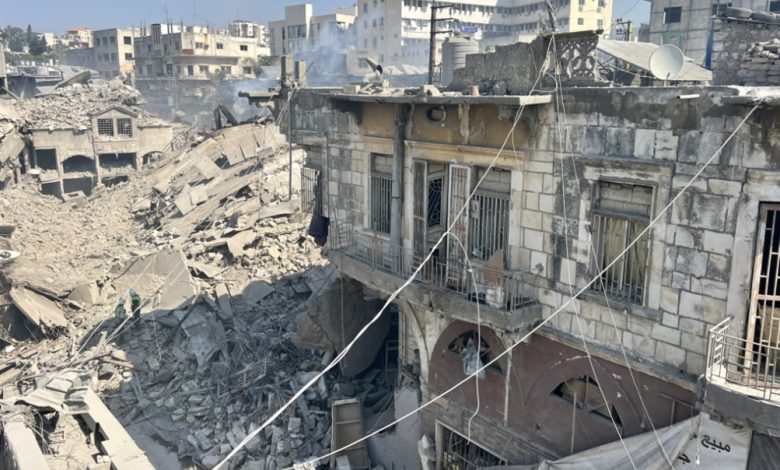أزمة السكن بعد الحرب في لبنان: البيوت الجاهزة خيار سريع لمواجهة الدمار
مع استمرار تداعيات الحرب الإسرائيلية على لبنان، تتزايد أزمة السكن في الجنوب والبقاع والضاحية الجنوبية لبيروت، حيث أصبح الطلب على البيوت الجاهزة في ازدياد كبير كحل سريع وعملي للمواطنين الذين فقدوا منازلهم.
البيوت الجاهزة كبديل مؤقت للسكن والمشاريع التجارية
يتوجه العديد من المتضررين إلى شراء البيوت الجاهزة كحل سريع ومؤقت يعوضهم عن المنازل التي دمرها القصف الإسرائيلي. ومن هؤلاء، نادر بدر الدين، أحد سكان مدينة النبطية، الذي فقد منزله وصيدليته بسبب القصف العنيف في 18 تشرين الثاني الماضي.
اتخذ بدر الدين قرار شراء منزل جاهز فور تأكده من فقدان منزله نهائيًا، فتواصل مباشرة مع أحد أصحاب المصانع في النبطية، وطلب تصميم بيت مناسب ليكون صيدلية مؤقتة. لم يكن التحدي في شراء المنزل فحسب، بل في وضعه في الموقع المناسب بسبب الدمار الواسع، مما دفعه لإزاحة الركام بنفسه قبل افتتاح صيدليته الجديدة في 18 كانون الأول.
تزايد الطلب على البيوت الجاهزة في لبنان
تشهد معامل تصنيع البيوت الجاهزة ارتفاعًا في الطلب بنسبة 50% بعد الحرب، وفقًا لما أكده عبود الحلبي، صاحب أحد المصانع في منطقة العبدة. ويشير الحلبي إلى أن أغلب الطلبات تأتي من الجنوب والبقاع، تليها الضاحية الجنوبية لبيروت، حيث يسعى الأهالي وأصحاب المحال التجارية لإعادة بناء مشاريعهم بسرعة.
من بين الاستخدامات المختلفة للبيوت الجاهزة، هناك صالونات الحلاقة، متاجر بيع المواد الغذائية، محلات بيع الإطارات والمكاتب. كما أن تكلفتها المنخفضة وسرعة تركيبها جعلتها خيارًا مثاليًا، حيث يمكن تجهيز منزل مكون من غرفتين، مطبخ وحمام بـ9,000 دولار فقط، مع 500 دولار إضافية لنقله، ليتم تسليمه خلال 10 أيام فقط.
المنازل الجاهزة مقابل المنازل التقليدية: أيهما أفضل؟
يفضل بعض اللبنانيين استئجار المنازل التقليدية بدلًا من شراء البيوت الجاهزة، نظرًا لكونها أكثر راحة للعائلات الكبيرة. لكن مع ارتفاع إيجارات المنازل بسبب قلة العرض بعد الدمار الواسع، يبقى البيت الجاهز حلًا مناسبًا لمن لم يجدوا بدائل سكنية أخرى.
بالإضافة إلى ذلك، لا يزال كثير من اللبنانيين يؤجلون إعادة إعمار منازلهم، انتظارًا للتأكد من وقف إطلاق النار الدائم وتأمين تعويضات للمتضررين.
مستقبل قطاع البيوت الجاهزة في لبنان
مع ازدياد التحديات التي تواجه قطاع الإسكان في لبنان بعد الحرب، يبدو أن البيوت الجاهزة أصبحت خيارًا رئيسيًا للكثيرين، سواء للسكن المؤقت أو للأعمال التجارية، مما يعكس تحولًا في أساليب إعادة الإعمار في ظل الظروف الصعبة.
Lebanon’s Housing Crisis After the War: Prefabricated Homes as a Quick Solution
In the aftermath of Israel’s war on Lebanon, the country is witnessing a severe housing crisis, particularly in southern Lebanon, Bekaa, and Beirut’s southern suburbs. As a result, many displaced residents are turning to prefabricated homes as a fast and practical alternative.
Prefabricated Homes: A Temporary Housing & Business Solution
Many displaced Lebanese are choosing prefabricated houses as a temporary and quick alternative to compensate for the homes they lost. One of them is Nader Badr Al-Din, a resident of Nabatieh, who lost both his home and pharmacy in an Israeli airstrike on November 18.
Upon realizing the extent of the damage, Badr Al-Din immediately contacted a local factory in Nabatieh and coordinated the design of a prefabricated home to serve as a pharmacy. However, installing the home was challenging due to the massive destruction, forcing him to clear the rubble himself before reopening his pharmacy on December 18.
Surging Demand for Prefabricated Homes in Lebanon
According to Aboud Halabi, the owner of a prefabricated home factory in Al-Abdeh, the demand for prefabricated homes has increased by 50% after the war. The majority of requests are from southern Lebanon and Bekaa, followed by Beirut’s southern suburbs, where residents and business owners are seeking fast reconstruction solutions.
The applications for prefabricated structures vary widely, including barbershops, grocery stores, tire shops, and offices. The affordability and quick assembly of these homes make them an attractive option. For instance, a 36-square-meter home with two bedrooms, a living room, a kitchen, and a bathroom costs only $9,000, plus $500 for delivery, and can be completed in just 10 days.
Prefabricated vs. Traditional Homes: Which Is Better?
While some Lebanese prefer renting traditional houses, arguing that prefabricated homes may not be suitable for large families, the sharp rise in rental prices due to the destruction of many residential buildings has left many with no choice but to consider prefabricated housing.
Additionally, many Lebanese are delaying the reconstruction of their homes, waiting for a permanent ceasefire agreement and potential compensation for war damages.
The Future of Prefabricated Homes in Lebanon
With Lebanon’s post-war housing crisis intensifying, prefabricated homes have emerged as a leading alternative for both residential and commercial use, marking a new shift in the country’s reconstruction efforts in the face of growing economic and infrastructural challenges.
Translated by economyscopes team
المصدر: حنان حمدان – الشرق الأوسط
 سكوبات عالمية إقتصادية – EconomyScopes إجعل موقعنا خيارك ومصدرك الأنسب للأخبار الإقتصادية المحلية والعربية والعالمية على أنواعها بالإضافة الى نشر مجموعة لا بأس بها من فرص العمل في لبنان والشرق الأوسط والعالم
سكوبات عالمية إقتصادية – EconomyScopes إجعل موقعنا خيارك ومصدرك الأنسب للأخبار الإقتصادية المحلية والعربية والعالمية على أنواعها بالإضافة الى نشر مجموعة لا بأس بها من فرص العمل في لبنان والشرق الأوسط والعالم




